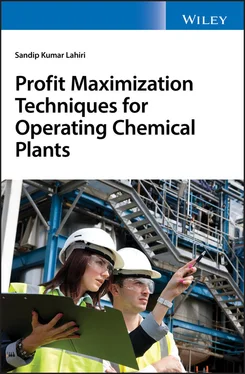This book provides engineers in all practical aspects of a profit maximization project in running plants, as well as expert guidance on how to derive maximum benefits. The book will present the core of a systematic approach covering profit optimization strategy, solution methodology, supporting structure, and assessment methods. In short, it will describe what it takes to make sizable reductions in operating costs for process plants and how to sustain profit improvement benefits.
Short on theory and long on step‐by‐step information, it covers everything plant process engineers and technical managers need to know about identifying, building, deploying, and managing profit improvement applications in their companies. Readers are able to take away methods and techniques for identifying, analysis, optimization, engineering design, and monitoring that are required to identify, assess, implement, and sustain profit improvement opportunities.
The main feature of this book, which differentiates it from other available books on the market, is its practical content, which helps the reader to understand all the steps of profit maximization project implementation in an actual commercial plant. The key features of this book that differentiate it from other available chemical engineering books are summarized below:
The reader can develop a thorough understanding of steps for building a profit maximization application in running a chemical plant. All practical considerations to identify, build, and deploy a profit improvement project in the commercial running of the plant form the essence of this book.
The benefits of this effective approach include identification of large profit improvement projects by applying assessment methods, capturing hidden opportunities in process operation by the use of advance monitoring and fault diagnosis, increasing plant capacity by a systematic way of performing a test run and debottlenecking study, optimizing process performance through various online conventional and stochastic optimization procedures, pushing the plant operation towards multiple constraints by advance process control, and maintaining continuous improvement by using regular review and performance matrices.
The chapter contents are described below.
Concept of Profit Maximization
The first chapter contains the foundation of the profit maximization project in running process industries. Sweating of assets and deriving maximum benefit from assets forms the essence of profit maximization. After implementation of data historian software in the last decade, todays chemical process industries (CPI) are very data rich but unfortunately remain information poor. No effective platform is still available to utilize this large amount of data. This chapter explains the emergence of knowledge‐based industries and only CPIs employing knowledge to drive the business are likely to survive in the future. This essentially means generating an effective platform that can generate knowledge from available business data and use this knowledge to develop a unified framework to support faster business decisions to respond to external market uncertainties. This chapter gives an overview of how to build a framework where advanced computational knowledge and experience‐based heuristics are applied to utilize this wealth of data to maximize profit. In simple terms, profit maximization means maximization of dollar ($)/h generation from the plant while subject to constraints that all process and safety constraints need to be honored and all equipment limitations should not be violated. The need for profit maximization in today's competitive market is explained in this chapter.
Big Picture of the Modern Chemical Industry
Currently the chemical industry is slowly entering into a new era called the data analytics and artificial intelligence stage, commonly known as industry 4.0. Disruptive technologies like artificial intelligence, machine learning, big data analytics, and the internet of things (IoT) have already entered the chemical process industries and have started to change the rules governing the chemical business. Chapter 2explains how the transition from a conventional to an intelligent chemical industry is slowly taking place. Their influence is starting to see benefits in a significant improvement in production efficiency, energy utilization, optimization of the entire manufacturing process, integration of the supply chain, new product development, product delivery speed, etc. As of now, it is quite clear that digital will have a significant impact on many areas of the chemical industry, with the gains in manufacturing performance potentially among the largest. This chapter gives an overview of how digital will affect the chemical industry and where the biggest impact can be expected. There are three major areas where applications of an advanced analytic tool can give an enormous profit increase, namely predictive maintenance; yield, energy, and throughput analytics; and value‐maximization modeling. This chapter gives insights about how to achieve a business impact using data and introduces the concept of how valuable data analytics and upstream and downstream activities can result in achieving a business impact.
Profit Maximization Project (PMP) Implementation Steps
Chapter 3describes different steps for implementing a profit maximization project. It introduces 14 major broad ideas or steps for profit maximization in running commercial plants. These ideas are described in detail in subsequent chapters throughout the book. These generic steps are holistic and can be applied in any process industry, starting from refinery, petrochemical, chemical plants, metals, pharmaceuticals, paper and pulp industries, etc. It starts with mapping the whole plant in monetary terms (US$/h) instead of flow terms. This gives an idea of where to focus maximization of the profit and what low hanging fruits are needed that can be easily translated to increase profit without much investment. Practical guidelines to build a profit maximization framework, easily implementable solutions, numerous examples, and case studies from industries give a completely new computational approach to solve process industry problems and are the hallmark of this book.
Strategy of Profit Maximization
A strategy of profit maximization is the essence of Chapter 4. This chapter describes different ways to maximize the operating profit. The concept of process cost intensity and how to calculate it are introduced in this chapter. The procedure for mapping the whole process in monetary terms and gain insights is described by way of an ethylene glycol plant case study.
This chapter describes in detail eight key steps in mapping current process conditions against different process constraints and limits. The first three major steps are (i) define plant business and economic objectives, (ii) identify various process and safety limitations, and (iii) critically identify the profit scope. Key parameter identification steps for economics, operations, and constraints of the plant are discussed in detail. How to evaluate and exploit potential optimization opportunity is discussed with industrial case studies.
Key Performance Indicators and Targets
Knowing what key operating parameters to monitor and defining the targets and limits for these parameters is an important step for profit optimization. We also need to know the economic values of closing gaps between actual and targeted performances to create incentives for improvement. This chapter deals with how to identify the key performance parameters in running the plant and the whole process is explained with a real‐life commercial plant case study. It provides a methodology to identify qualitatively potential areas of opportunities. The system of key indicators is the cornerstone of a sustainable profit management system.
Читать дальше












